(Other opinions are welcome too.)
Hi Coaly, My wife and I recently bought a home (rancher) that was built in the mid 70's in northern Maryland.
Upstairs is a Fisher Insert & and downstairs in the basement is the Grandpa Bear (from what I can tell from this forum, I'm pretty sure it is a grandpa).. We've had several chimney companies come out to the house to inspect our chimneys and give estimates for repairs. (3 flues total, both Fishers, and also the furnace flue).
All existing flues are clay tile and show signs of wear (the plan is to have them all replaced with modern stainless liners).
Question 1: All the chimney companies agreed that the Fisher insert (which they all called a "slammer") needed to be removed (for safety reasons) and replaced with a modern insert in combination with a 6-inch stainless liner. I've read about "slammers" on the internet and there does seem to be a safety concern out there that is consistent with what the chimney companies were saying. So my question is, are "slammers" dangerous, and should I replace the Fisher insert.. It seems a shame because it is a cool piece.. I thought I would ask you (who seems to be a Fisher expert) if you had any thoughts on the "slammer" matter.
Question 2: The downstairs Grandpa Bear is connected to 7inch square clay tile chimney flue. 2 out of 3 chimney companies said that the existing flue was fine. All three companies want to replace the black stove pipe from stove to wall (this makes sense as it is a bit rusty).. 1 out of 3 companies (and the one we like the best) wants to break up and remove the clay tile flue and replace with a 8inch stainless steel modern liner and then connect the grandpa bear. I've been getting some pressure from outside opinions to replace the "old" fisher (grandpa) with a more efficient/modern woodstove with a 6inch outlet/liner (avoiding breaking out the current 7inch tile). I've read on some of your posts about the baffling trick to add some efficiency. I may inquire more about that later. Right now I'm planning on keeping the grandpa bear and letting the chimney company reline the chimney with a 8inch liner and replace the black stove pipe and light a fire. I really like the stove and just want to use it. It seems as though there is a high regard to Fisher Stoves and I think it would be a shame to take out the grandpa bear. Any thoughts on this Coaly?? Does the plan make sense for the 8 inch liner?
Anyway, Thanks for thoughts and opinions in advance. I'm very new to all of this.
Tom.
-I've uploaded some photos of my stoves so you can see what I have. (hopefully the photos work).
Hi Coaly, My wife and I recently bought a home (rancher) that was built in the mid 70's in northern Maryland.
Upstairs is a Fisher Insert & and downstairs in the basement is the Grandpa Bear (from what I can tell from this forum, I'm pretty sure it is a grandpa).. We've had several chimney companies come out to the house to inspect our chimneys and give estimates for repairs. (3 flues total, both Fishers, and also the furnace flue).
All existing flues are clay tile and show signs of wear (the plan is to have them all replaced with modern stainless liners).
Question 1: All the chimney companies agreed that the Fisher insert (which they all called a "slammer") needed to be removed (for safety reasons) and replaced with a modern insert in combination with a 6-inch stainless liner. I've read about "slammers" on the internet and there does seem to be a safety concern out there that is consistent with what the chimney companies were saying. So my question is, are "slammers" dangerous, and should I replace the Fisher insert.. It seems a shame because it is a cool piece.. I thought I would ask you (who seems to be a Fisher expert) if you had any thoughts on the "slammer" matter.
Question 2: The downstairs Grandpa Bear is connected to 7inch square clay tile chimney flue. 2 out of 3 chimney companies said that the existing flue was fine. All three companies want to replace the black stove pipe from stove to wall (this makes sense as it is a bit rusty).. 1 out of 3 companies (and the one we like the best) wants to break up and remove the clay tile flue and replace with a 8inch stainless steel modern liner and then connect the grandpa bear. I've been getting some pressure from outside opinions to replace the "old" fisher (grandpa) with a more efficient/modern woodstove with a 6inch outlet/liner (avoiding breaking out the current 7inch tile). I've read on some of your posts about the baffling trick to add some efficiency. I may inquire more about that later. Right now I'm planning on keeping the grandpa bear and letting the chimney company reline the chimney with a 8inch liner and replace the black stove pipe and light a fire. I really like the stove and just want to use it. It seems as though there is a high regard to Fisher Stoves and I think it would be a shame to take out the grandpa bear. Any thoughts on this Coaly?? Does the plan make sense for the 8 inch liner?
Anyway, Thanks for thoughts and opinions in advance. I'm very new to all of this.
Tom.
-I've uploaded some photos of my stoves so you can see what I have. (hopefully the photos work).
Attachments
Last edited:


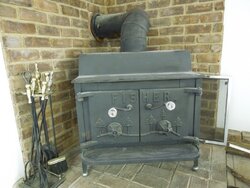
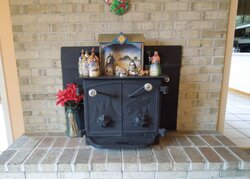
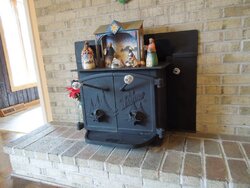
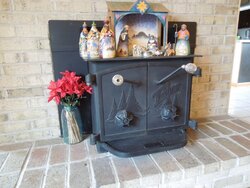
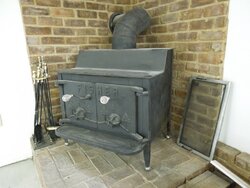
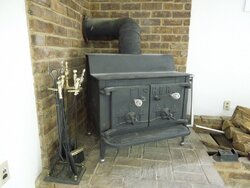
 I understand what you are saying about radiant heat and possible power outages...
I understand what you are saying about radiant heat and possible power outages...